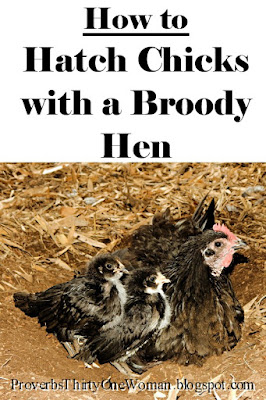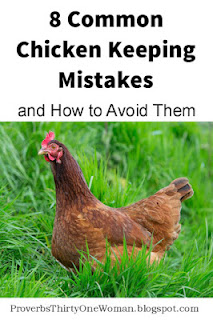Do you have a hen who sits persistently on eggs? Some people get frustrated when this happens, but being the frugal and practical homesteader I am, I've learned to embrace this behavior as mostly useful. I don't care for keeping chicks in a brooder, and I dislike the expense of buying fertilized eggs and an incubator. When possible, I'd rather let a hen do all the work for me!
Unfortunately, allowing hens to hatch and care for chicks is a dying practice. Commercial hens are bred to minimize their "broody" (i.e. motherly) behavior (because broody hens don't lay eggs and a hen that's not laying eggs costs the farmer money). Even backyard homesteaders tend to see broody hens as a "pain." Therefore, there's very little information in books or magazines on how to raise chicks with a hen. This article hopes to correct that by showing you what works for me.
Broody Chicken Breeds
I was blessed to begin with an excellent breed: Australorpes. I've blogged before about how they are my favorite breed: gentle and docile, excellent layers (even through winter), not caring about hot or cold weather...but they also happen to be good mothers and are more likely to go broody than some breeds. Other breeds that may have a stronger proclivity toward broodiness include: Ameraucana, Araucana, Light and Buff Brahma, Cochin, Buff Rocks, Dark Cornish, Delaware, Dominique, Dorking, Holland, Java, Jersey Giant, New Hampshire, Buff Orpington, Plymouth Rock, Turkens, Cuckoo Marans, Sussex, Cochin bantams, Cornish bantams, and Silkies.
But even when you choose good breed, not every hen will go broody. One thing I have learned, however: Don't judge a hen too soon. It can take a year or two before even the best mother hen decides to go broody.
 |
| Our rooster, Joe. |
We were thrilled to add a rooster to our flock a couple of years ago. He's a good protector of the flock and our girls just seem happier with him around. And, of course, he fertilizes our eggs. (Some people think fertilized eggs have blood spots in them, but this is a myth. And yes, fertilized eggs taste just like unfertilized eggs. Only upon close examination of an uncooked yolk can you tell that the egg is fertilized. Click here to learn how.) Young roosters may not get the job done consistently, though, so bear that in mind.
But what if you don't want or can't have a rooster? Fortunately, you can buy fertilized eggs. Look for ads on Facebook Marketplace and Craigslist. Or, conspire with another homesteader who has a rooster. I'll bet you can make a nice barter for fertilized eggs.
Encouraging Broody Behavior
When it comes to successfully and naturally hatching chicken eggs, some seasons are better than others. It's difficult for chicks to thrive when the weather is very hot or very cold, so plan accordingly. Fortunately, a good broody hen knows this, and she'll tend to only go broody when the timing is right - usually in spring (and sometimes in early fall).
To encourage your hen to go broody, there are a few things you can do. The most obvious is to leave the eggs in the nesting box, rather than collecting them. Some people like to put a "clutch" of golf balls or other fake eggs in the nest instead.
You'll know the hen is ready to be a mama when she refuses to leave the nest even when shooed away and she spends all her time on the clutch. After a few days have passed, she'll pluck feathers from her breast (so her skin is in direct contact with the eggs) and her body temperature will noticeably rise.
Preparing the Nest
 |
| One of our broody hens feeling protective of her clutch. |
It's certainly fine to allow the hen to make her own nest, but sometimes it's better to give her a little help. The biggest problem I've seen is that when the hen gets up from the nest for a quick bite of food or a little drink, the other hens may invade her nest. This can not only lead to broken eggs, but it can cause problems at hatching time. If there are eggs of multiple ages in the nest, obviously not all of them will hatch at the same time. This can lead to eggs that must be thrown away due to immature chicks inside them. (Some hens will refuse to leave unhatched eggs in the nest, which means they aren't properly caring for their chicks.)
This is why I think it's better to place the broody hen in her own, separate cage. It doesn't have to be big - just big enough for the nest, some water, and some food - but it must be predator-proof and offer shelter from the weather. A rabbit hutch or small chicken run with a roof and plenty of bedding works well.
Because transferring the hen and her eggs can lead to the hen refusing to sit, I like to collect fertilized eggs until I have the number I want to hatch. Examine each egg for cracks, holes, or odd shapes or sizes. Place only the most perfect eggs in a plastic egg box that's been washed in hot, soapy water. (Why not use ordinary egg cartons, you may ask? They may have bacteria that will transfer to the eggs, causing hatching woes.) Store the eggs point-side down in a cool location (ideally 55 degrees F., out of direct sunlight). To help prevent the embryos from sticking to the shells, place a book under one end of the container; each day, move the book to the opposite end of the container.
Every day an egg goes without incubation, it becomes a bit less viable. It is generally not considered hatchable after 7 days.
Never wash eggs you wish to hatch, since this removes their natural bloom, which protects the chicks from bacteria.
How many eggs should you collect for hatching? Generally, most hens can sit on up to a dozen eggs of the size they naturally lay. If you're unsure, collect more than you think you need, and if you find the hen has more than she can handle after a day or two of sitting, remove the excess.
Transfer the collected eggs, and then the hen, to the prepared nest. Don't worry if the hen doesn't immediately sit on the eggs. She can take up to a day to begin sitting in earnest and still have a successful hatch.
A word of caution: Lice and red mites can kill sitting hens, so a thorough examination is necessary before you let any hen sit on a clutch. If your flock has had red mite issues in the past, it's best to dust the hen with red mite powder, even if you see no signs of mites.
Caring for a Broody Hen
Even though broody hens don't eat or drink much, check her water and food levels every day, giving fresh water as needed. (Hens may lose up to 20 percent of their weight while incubating eggs; this is why hens should never be allowed to raise more than 2 clutches a year.)
It's also smart to pay attention to how much the hen is sitting. Some hens start out very broody, but lose interest and don't sit enough to keep the eggs warm. If that happens, you're out of luck and will need to throw the eggs away.
Some people like to candle eggs to ensure the hen isn't sitting on any rotten ones. But remember: every time you handle eggs, you increase the risk of hatching problems. The benefit of candling is that you can remove eggs that don't have developing embryos; if you leave them in the nest, they'll rot, making a stinky mess if they break.
Always remove any smelly eggs or eggs the hen rejects.
If you choose to candle the eggs, handle them gently, removing and replacing them one at a time. It's best to wait to candle eggs until day 7. After day 15, don't handle the eggs again.
 |
| Our hen caring for a few of her chicks. |
Around day 21, the chicks should begin hatching. Typically, they'll hatch out within a few hours of each other, but it can take anywhere from 12 hours to 3 days for the entire clutch to hatch.
After a few chicks are born, the hen will do one of three things. She'll either get off the nest to care for her chicks, leaving the remaining unhatched eggs to rot. Or she may remain on the nest and not do much for her hatched chicks (which is okay if you've isolated the hen and she still lets the chicks get warm under her). Or, most typically, the hen tends to her babies, leaving the eggs for a short time, but returning to sit if she senses the chicks within are still viable.
 |
| Keep the chicks separate from the rest of the flock. |
Once all the viable eggs have hatched, keep on eye on the hen to ensure she's a good mother. In rare instances, she might peck and kill the chicks, or ignore them altogether.
In addition, you'll need to put a chick waterer and feeder in the cage. Within days, a good mother will show her chicks how to use them.
I recommend letting the hen and her chicks stay in a separate cage for at least a week. Some people transfer the mother and babies to the main hen house right away, but mother hens are not always good at protecting their chicks. Also, as I learned the hard way, if you have a hen house that's raised off the ground, chicks may fall off the house ramp and die. Instead, I now put the mother and chicks in an old wire run set inside the main chicken run. (I cover the wire run with a tarp at night.) This gives the mother and chicks more room while also allowing the rest of the flock to get to know the chicks.
Wait at least a week before allowing the mother and chicks to enter the flock without protection. Stand by and make sure the other chickens don't harm the babies, though it's normal for them to peck the chicks out of curiosity. A good mother will peck and chase off any bird that comes near. If all seems well, leave the flock for perhaps 30 minutes, then check them again. Check periodically throughout the day until you are satisfied the mother can protect her chicks from the flock.
Final Pointers
The mother hen will continue to do most of the work of raising the chicks, but you should ensure there are plenty of water sources available, since occasionally fully grown chickens may bully chicks away from waterers. Also pay attention to the height of the waterers. If chicks can't easily reach them, set out supplemental chick waterers.
In addition, pay attention to what type of feed you offer. If you've been giving the chicks medicated starter feed, you'll need to switch to a non-medicated variety - because adult chickens love chick food. At 8 weeks, the chicks are ready for grower feed, which ups the protein they consume, ensuring optimal growth. Another option is to switch directly to flock feed once the chicks are integrated with the rest of the chickens; some experts say this doesn't provide enough protein for chicks, but this is less of a problem when your flock gets some free-range time than if your flock is caged. Whatever feed you select, don't give chicks layer feed; its high calcium levels can damage their bones and muscles. A good rule of thumb is to switch to layer feed at 18 - 20 weeks.
Related Posts:














No comments